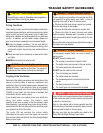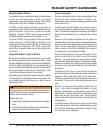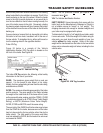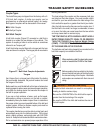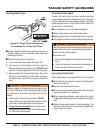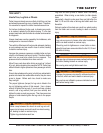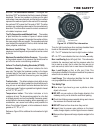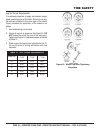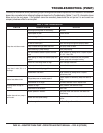
PAGE 42 — MQ62TDD TRASH PUMP • OPERATION AND PARTS MANUAL — REV. #0 (07/30/09)
Determining Load Limit of Trailer
Determining the load limits of a trailer includes more than
understanding the load limits of the tires alone. On all trailers
there is a Federal certification/VIN label that is located on
the forward half of the left (road) side of the unit. This
certification/VIN label will indicate the trailer’s Gross Vehicle
Weight Rating (GVWR). This is the most weight the fully
loaded trailer can weigh. It will also provide the Gross Axle
Weight Rating (GAWR). This is the most a the axle can
weigh.
There is a vehicle placard (Figure 30) located in the same
location as the certification label described above. This
placard provides tire and loading information. In addition,
this placard will show a statement regarding maximum
cargo capacity.
If additional work items (hoses, tools, clamps etc.) are going
to be added to the trailer, be sure they are distributed evenly
to prevent overloading front to back and side to side. Heavy
items should be placed low and as close to the axle
positions as reasonable. Too many items on one side may
overload a tire.
Excessive loads and/or underinflation cause tire
overloading and, as a result, abnormal tire flexing occurs.
This situation can generate an excessive amount of heat
within the tire. Excessive heat may lead to tire failure. It is
the air pressure that enables a tire to support the load, so
proper inflation is critical. The proper air pressure may be
found on the certification/VIN label and/or on the Tire
and Loading Information placard. This value should never
exceed the maximum cold inflation pressure stamped on
the tire.
TIRE SAFETY
Figure 30. Tire and Loading Information
Placard
The weight of cargo should never exceed XXX kg. Or XXX lbs
.
TIRE
FRONT
REAR
SPARE
SIZE
COLD TIRE PRESSURE
TIRE AND LOADING INFORMATION
SEE OWNER’S
MANUAL FOR
ADDITIONAL
INFORMATION
Step 1.
Locate the statement, “The weight of cargo should never
exceed XXX kg or XXX lbs.,” on your vehicle’s
Tire and Loading Information placard(Figure XX). This figure
equals the available amount of equipment load capacity.
Step 2.
Determine the weight of the equipment being loaded on
the tow vehicle. That weight may not safely exceed the
available equipment load capacity. The trailer’s Tire
Information Placard is attached adjacent to or near the
trailer’s VIN (Certification) label at the left front of the trailer
(See Figure 33).
Determining Load Limit of Tow Vehicle
Step 1.
Locate the statement, “The combined weight of
occupants and cargo should never exceed XXX lbs.,” on
your vehicle’s placard.
Step 2.
Determine the combined weight of the driver and
passengers who will be riding in your vehicle.
Step 3.
Subtract the combined weight of the driver and
passengers from XXX kilograms or XXX pounds.
Step 4.
The resulting figure equals the available amount of cargo
and luggage capacity. For example, if the “XXX” amount
equals 1400 lbs. and there will be five 150 lb.
passengers in your vehicle, the amount of available cargo
and luggage capacity is 650 lbs. (1400-750 (5 x 150) = 650
lbs.).
Step 5.
Determine the combined weight of luggage and cargo being
loaded on the vehicle. That weight may not safely
exceed the available cargo and luggage capacity
calculated in Step 4.
If your vehicle will be towing a trailer, load from your trailer
will be transferred to your vehicle. Consult the tow vehicle’s
manual to determine how this weight transfer reduces the
available cargo and luggage capacity of your vehicle.



